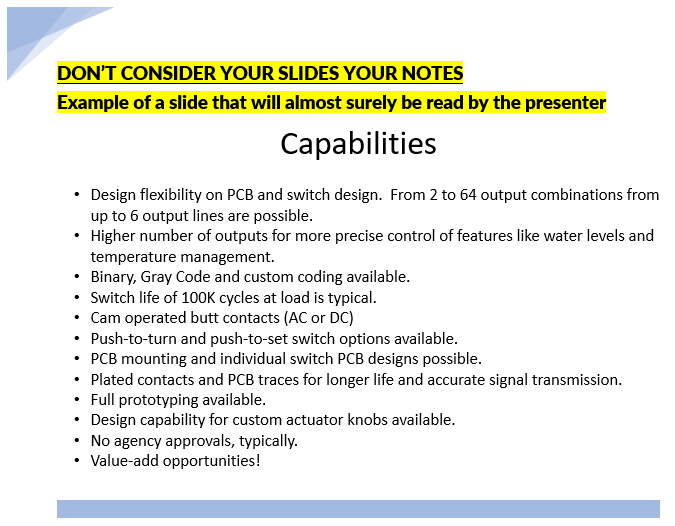Using notes in public speaking seems simple, but using them well sets good speakers apart. There are three changes you can make to your notes that will make you a better presenter.
It’s August, and that means back-to-school time. The stores are already prepared. Moms and dads are counting down with anticipation. Kids are rehearsing the “I don’t wanna go back…” speeches with incredible facial expressions and intonations. It’s time to get back to taking notes.
Let’s talk about those notes. But not the notes you take from someone else speaking — the notes you make so that YOU can speak well.
First and foremost, in almost any circumstance, speaker notes are OK. Notable (pun intended) exceptions: Broadway stage performances, some interview questions (“What do you like most about our company?” “Uh, let me check…”), and… that’s about it. The President uses notes. Preachers and teachers use notes. TED speakers use notes. And you probably should, too.
The most common comment I get when coaching someone for a talk is, “When I get more familiar with my content or memorize it, I’ll be better.” And they probably will. But then in the heat of the moment when anxiety is high, or maybe just a senior moment where your brain can’t recall the next sentence, or when you get two parts of your speech mixed up, you’ve got to get back on track. And THAT’s the reason for notes. To remind you of what you need to say.
But most speakers use notes poorly and think that a full-developed manuscript will help them in their time of need. Most often, this is the opposite of what happens. You’re rolling along from memory, but then need to catch a glance. Where is that next word? Is it down an inch? Over two? On the next page? How can I spot my place quickly? The heart races. The eyes flit. Often an apology comes out (please don’t apologize! or bring attention to your mistakes). The problem is in bad notes and bad usage of notes. There are three changes you can make to your notes that will make you a better presenter.
Three Tips for Using Notes in Public Speaking
1. Don’t consider your slides your notes.
Most business presentations hide their notes in plain view of the audience – on their slides. You know they’re the speaker’s notes because his/her head is constantly turned and looking at them. If I could have one wish for presentations everywhere, it would simply be this: don’t ever read slides. I can read. Your notes are better on a piece of paper that only you can see. Or perhaps in the Notes section of PowerPoint (they even named it for you!). But now you’re depending on technology.

Don’t consider your slides your notes
2. Don’t speak to your notes. Ever.
Look at them all you want. But don’t let words come out of your mouth while you’re looking at them. This takes practice. Most people want to speak as soon as their brain figures out what to say. This causes a rush and frequently a popping or clucking sound as the speaker rushes to utter those precious words. But that pressure is manufactured in the speaker’s brain, where a slight pause to find your place feels like an eternity. The audience likely doesn’t even notice.
3. Make the notes personal.
I’m not a fan of speaking from a manuscript for the reasons listed above. Sure, you can write out your manuscript to get it right (tip: READ it out loud so that it sounds great, not just reads great – there’s a difference between spoken speech and a written speech). But there is no reason you have to have every word scripted (exceptions: state-of-the-union addresses and funerals). Jot down keywords and phrases that remind you of what to say. You can make a very nice-sounding sentence from one keyword. Increase the font. Start every new thought at the left margin so your eyes know where to go to find them. Use ample white space (there is no penalty for an additional page of notes!) Use shorthand and codes to remind you of gestures, facial expressions (😊!), or movement. In short, make the notes work for YOU. No one else will ever see them.
I had a seminal moment about notes when I was trying out some new material for a repeat client one day. Since the content was new, of course I needed notes. I think I consulted them about a hundred times in my hour and a half. But thankfully, I’ve developed the habit to speak to eyes, not notes, and we teach that pauses while walking are interpreted by the audience as confident interludes. I used those moments to return to the lectern and look at my notes. I felt really off and was mad at myself for not being more familiar with my content.
When I was done, an audience member made a beeline for me with that, “I’ve got a question” look. And here it came: “Can you tell me how you can speak for an hour and a half without notes?” The pause felt like an eternity. The look on my face was one of confusion. Were you in the room? Did you not notice how many times I consulted my notes? Did you see how attached I was to the lectern? Apparently, she had not noticed. And I realized that those pauses were a welcome respite for audience brain’s trying to take in a lot of information. My use of notes – not READING notes – helped the audience process. And it helped me stay on track, on time, and on point. I frequently ramble when I know my material well. Notes make sure I say what I set out to say.
Use notes in public speaking. But use them well.
Communication matters. What are you saying?
Want more speaking tips? Check out our Free Resources page.
We can also help you with your speech with our Workshops or Personal Coaching.
This article was published in the August edition of our monthly speaking tips email newsletter, Communication Matters. Have speaking tips like these delivered straight to your inbox every month. Sign up today to receive our newsletter and receive our FREE eBook, “Twelve Tips that will Save You from Making a Bad Presentation.” You can unsubscribe at any time.



